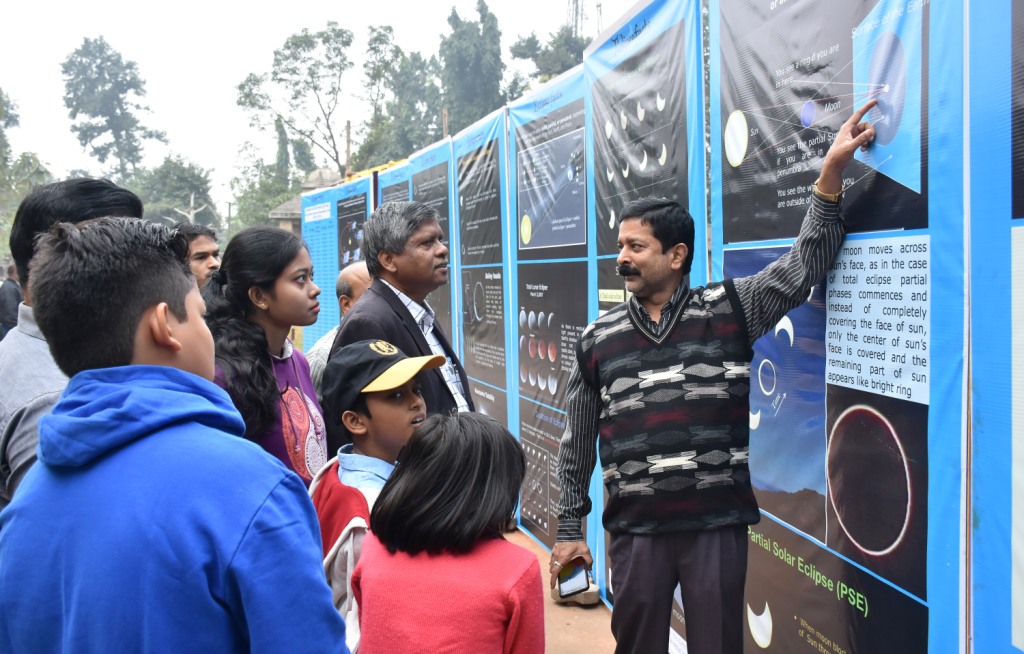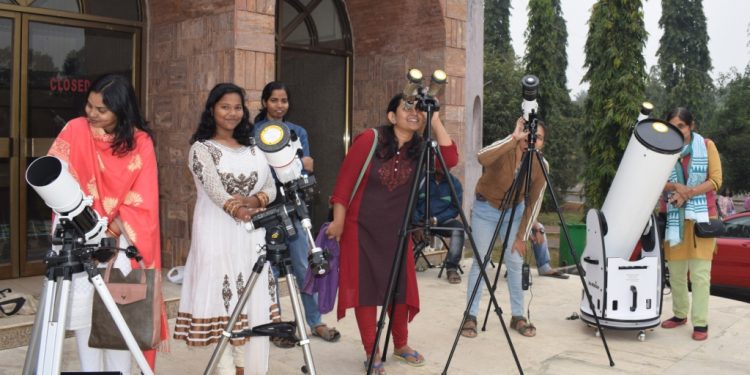Tens of thousands of tourists and locals gaped skyward, witnessing the last solar eclipse of the decade from the Capital
BHUBANESWAR: Excitement marked the viewing of the last solar eclipse of the decade at Pathani Samanta Planetarium here Thursday.
According to experts, the eclipse began at 8:20:08 am IST and ended at around 11:29 am.
On the occasion, planetarium authorities made all the arrangements for the viewing of the eclipse. Deputy director, Pathani Samanta Planetarium, Subhendu Pattnaik said “Elaborate arrangements have been made at the planetarium for the viewings of solar eclipse. Telescope and solar filters have been setup so that the public can view the eclipse safely without any harmful effects of the sun rays. Around 3000 viewers visited the planetarium to watch the eclipse.”
However, a massive cloud cover hampered the viewing of the phenomenon and left some of the visitors disappointed. The planetarium was expecting around four to five thousand people but the footfall was somewhat short due to bad weather conditions. Excited to view the eclipse safely, people started queuing up at the planetarium around 7 am. The partial eclipse was visible only for 10 minutes from 8.50 am to 9 am.

“Apart from this, arrangements have been made to provide solar glasses for the public with the help of which people can view the phenomenon. There is no danger in viewing the sun with the help of solar glasses. A Mylar sheet has also been installed at the planetarium with which the public can view the eclipse. The sessions were interactive and informative. We have made elaborate and adequate arrangements to accommodate maximum number of spectators,” he added. Special sessions by experts were also organised and informative posters were put up at the site.
Apart from the planetarium, Bigyan Chetana Mancha also organised eclipse viewing programmes at BJB college ground and Ravenshaw University.
Scientist Sidharth Vharadwaj said, “We have organised workshops on solar eclipse in different schools, colleges, universities and localities of Odisha to observe the rare celestial event of the year.”
Due to the eclipse, many shops, eateries and offices were closed in the city. Many people observed the ‘no eat no drink’ policy during the event. Indramani Jena, secretary, All Odisha Private Medical Establishment Forum, said, “Such beliefs are baseless and there is no scientific proof that people should not eat during the eclipse.”
“The only thing which needs to be taken care of is not viewing the Sun directly during the eclipse. Harmful rays may affect the retina,” he added.
Students were especially enthusiastic about watching the eclipse. They flocked to the viewing sites in large numbers. A student Sashikanta Khuntia said, “This is the second time that I watched an eclipse. I watched a lunar eclipse January 31 last year. Watching these celestial events is always a memorable experience. I also enjoyed the movie based on solar eclipse screened by the planetarium.”
There are three types of eclipses: one is a total solar eclipse, which is visible only from a small area on Earth. According to NASA, people who are able to view the total solar eclipse are in the centre of the moon’s shadow as and when it hits the Earth. A total solar eclipse happens when the sun, moon and Earth are in a direct line.
The second type of solar eclipse is a partial solar, in which the shadow of the moon appears on a small part of the sun. The third kind is an annular solar eclipse, which happens when the moon is farthest from the Earth, which is why it seems smaller. In this type of an eclipse, the moon does not block the sun completely, but looks like a ‘dark disk on top of a larger sun-colored disk’ forming a ‘ring of fire’.
Celestial phenomenon
A solar eclipse occurs when the Moon passes between Earth and the Sun, thereby totally or partly obscuring the Sun for a viewer on Earth. Partial phases of the solar eclipse will be visible from all over the country in varying magnitude depending upon the geographical position. When the annular solar eclipse takes place, sky watchers should use safe viewing equipment and proper techniques to view the celestial event as the infrared and ultraviolet rays of the Sun can cause severe retinal damage including blurry vision, black spots, and pain.







































